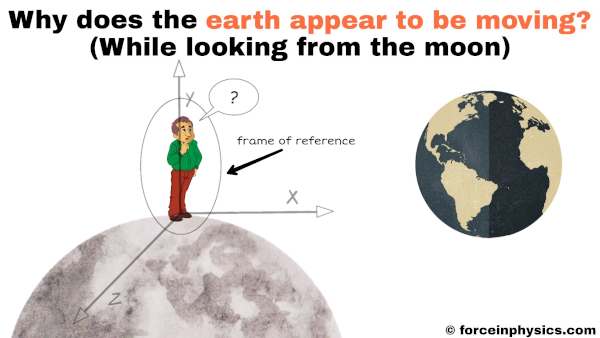
A frame of reference, also referred to as a reference frame, is a conceptual framework used to establish a coordinate system and a set of reference points. Its purpose is to provide a standardized means of measuring and describing the position, velocity, and other characteristics of objects within that frame. By defining a coordinate system and reference points, a frame of reference facilitates the consistent and accurate comparison and analysis of physical phenomena from a particular perspective.
Examples
Skateboarding
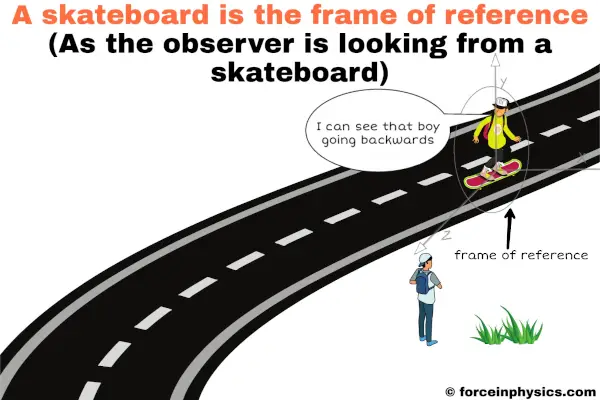
When someone rides a skateboard on the road, they may notice that the stationary objects around them seem to be moving backward. This perception arises because the skateboard serves as their frame of reference. As the person moves forward on the skateboard, objects in the environment, including people, appear to move in the opposite direction relative to their frame of reference. This phenomenon highlights the influence of the chosen frame of reference and the role it plays in our perception of motion.
Car
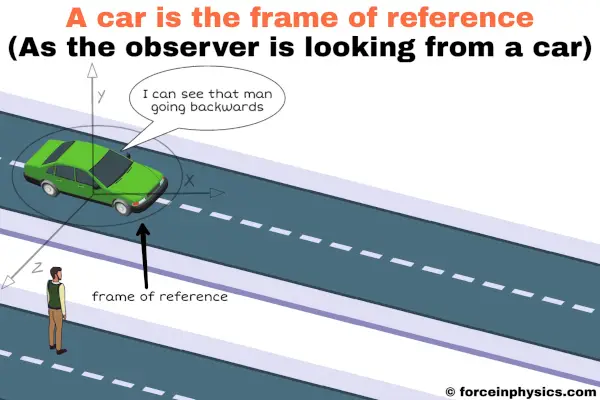
When driving a car, an individual may notice that a pedestrian walking on the road appears to be moving in the opposite direction. This perception is influenced by the frame of reference chosen, which is the car itself. From the perspective of the car, stationary objects and individuals on the road may seem to be in motion relative to the car’s own movement. This observation highlights the importance of considering the frame of reference when interpreting the motion of objects in relation to one’s own position and movement.
Train
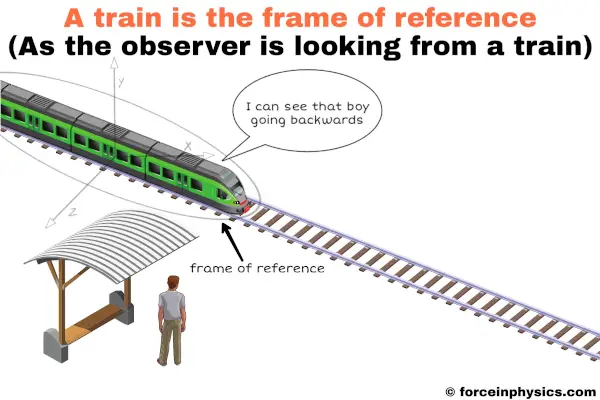
Imagine a train in motion, with an individual seated inside and observing the surroundings. From their vantage point, they will observe that the objects in the surrounding area, as well as the people on the platform, appear to be in motion. This observation is a consequence of the frame of reference they have chosen, which is the moving train itself. As the person inside the train moves along with it, they perceive the stationary objects on the platform as moving relative to their frame of reference.
Airplane
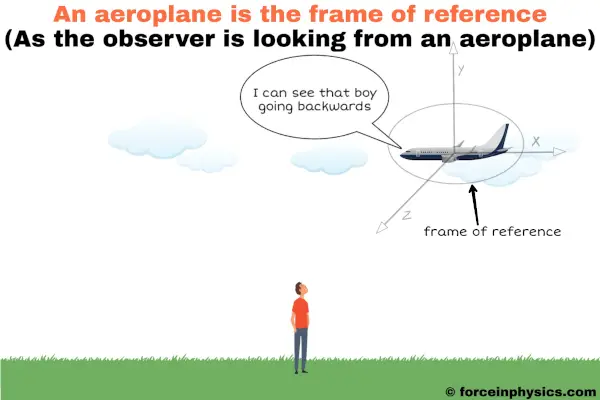
During an airplane takeoff, passengers may notice that the scenery outside seems to quickly move away from them. This happens because their frame of reference is the inside of the moving airplane. As the plane gains speed on the runway and lifts off the ground, the objects on the ground appear to move farther away from their perspective. This perception demonstrates how the chosen frame of reference impacts our understanding of motion during an airplane takeoff. It’s a result of the relative motion between the airplane and the stationary objects on the ground.
Types
Inertial frame of reference
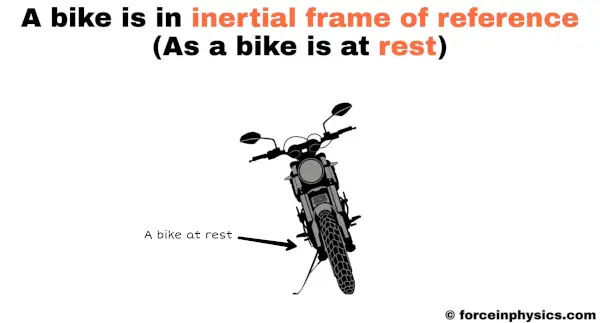
An inertial frame of reference is a concept in physics that refers to a frame in which Newton’s first law of motion holds true. Specifically, it is a frame that is not subjected to any net external forces or accelerations. In such a frame, objects at rest remain at rest, and objects in motion continue moving with a constant velocity in a straight line.
For example, let’s consider a stationary motorcycle on a level road. If no external forces, such as a push or friction, are acting on the motorcycle, and it is not experiencing any acceleration, the motorcycle can be considered to be in an inertial frame of reference. In this frame, the motorcycle will stay stationary until a force acts upon it, causing it to accelerate.
Non-inertial reference frame
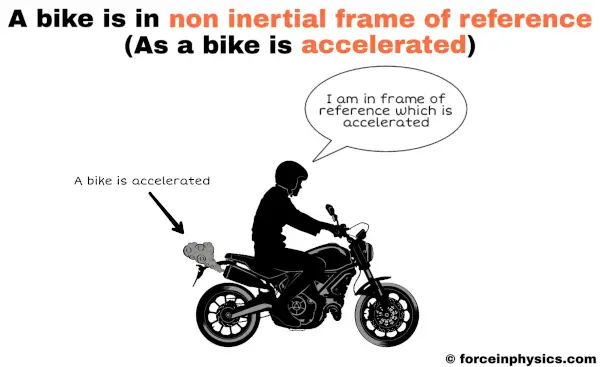
A non-inertial reference frame is a concept in physics that refers to a frame of reference that is subjected to acceleration. In contrast to an inertial frame, where Newton’s first law of motion holds true, a non-inertial frame experiences fictitious forces, which appear to act on objects within the frame but are, in fact, due to the frame’s acceleration.
For example, let’s consider a motorcycle taking a sharp turn on a curved track. From the perspective of an observer on the motorcycle, it may appear as though a force is pushing them outward, away from the center of the curve. This apparent force is known as the centrifugal force, and it is a fictitious force that arises due to the motorcycle’s acceleration and the non-inertial nature of the reference frame. In reality, there is no actual force pushing the observer outward; it is their inertia that causes them to continue moving in a straight line while the motorcycle turns.
In non-inertial reference frames, such as the accelerating motorcycle in this example, the laws of motion are more complex, and additional fictitious forces may need to be considered to accurately describe the behavior of objects within the frame.
Inertial vs non-inertial reference frame
| Definition | An inertial frame of reference is a frame in which Newton’s first law of motion holds true. It experiences no acceleration or net external forces. | A non-inertial frame of reference is a frame that is subjected to acceleration or non-zero net external forces. It does not satisfy Newton’s first law of motion. |
| Acceleration | No acceleration or net external forces are present in an inertial frame. Objects in this frame move with constant velocity or remain at rest. | Acceleration or non-zero net external forces exist in a non-inertial frame. Objects may experience apparent forces due to the frame’s acceleration. |
| Example | In an inertial frame, a stationary motorcycle on a level road with no external forces acting on it maintains its position and does not accelerate. | In a non-inertial frame, a motorcycle taking a sharp turn on a curved track experiences a centrifugal force directed away from the center of the curve. |
| Other name | Inertial frames are commonly referred to as Galilean reference frames. | Unlike inertial frames, non-inertial frames do not have a specific alternative name. However, they are commonly referred to as accelerated frames. |
| Newton’s law | Newton’s laws of motion hold true in an inertial frame. These laws describe the motion of objects accurately without the need for additional forces. | Newton’s laws of motion may not hold true in a non-inertial frame. To describe the motion accurately, fictitious forces like the centrifugal force or Coriolis force need to be considered. |
Related
- Frame of reference
- Newton’s first law
- Newton’s second law
- Newton’s third law
More topics
- Balanced force
- Unbalanced force
- Friction
- Tension (physics)
- Applied force
- Normal force
- Drag (physics)
- Gravity
- Centripetal force
- Centrifugal force
- Buoyancy
- Net force
- Compression (physics)
External links
- Frame of reference – Wikipedia
- Frames of Reference – Isaac Physics
- Chapter 11 Reference Frames – Lehman College
- Frame of reference definition in American English – Collins Dictionary
- Frame of Reference – ChangingMinds.org
- Frames of Reference – Lumen Learning
- Meaning of frame of reference in English – Cambridge Dictionary
- Frames of reference (video) – Khan Academy
- Frame of reference Definition & Meaning – Merriam-Webster
- Frames of Reference and Newton’s Laws – University of Virginia
- Frame of reference Definition & Meaning – Dictionary.com
- Space and Time: Inertial Frames – Stanford Encyclopedia of Philosophy
- Frame of Reference – Fort Bend Independent School District
- Reference frame | Definition, Types & Examples – Britannica
- Frame of reference – Definition, Meaning & Synonyms – Vocabulary.com
- Frame of Reference: Overview & Definition – Vaia
- Frame of Reference – Scholarly Community Encyclopedia
- Frame of reference – Academic Kids
Deep
Forceinphysics.com was founded by Deep Rana, who is a mechanical engineer by profession and a blogger by passion. He has a good conceptual knowledge on different educational topics and he provides the same on this website. He loves to learn something new everyday and believes that the best utilization of free time is developing a new skill.
